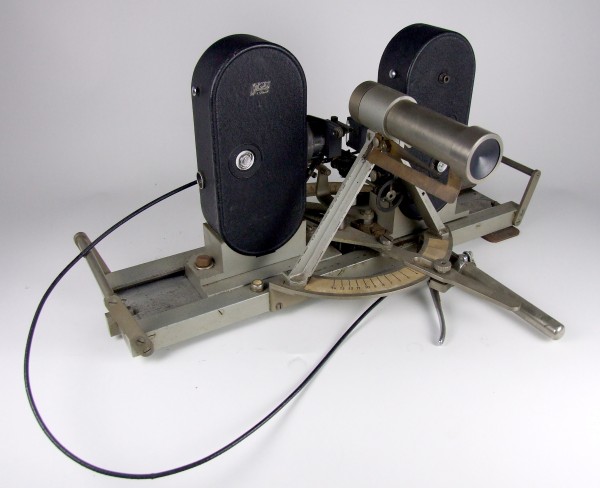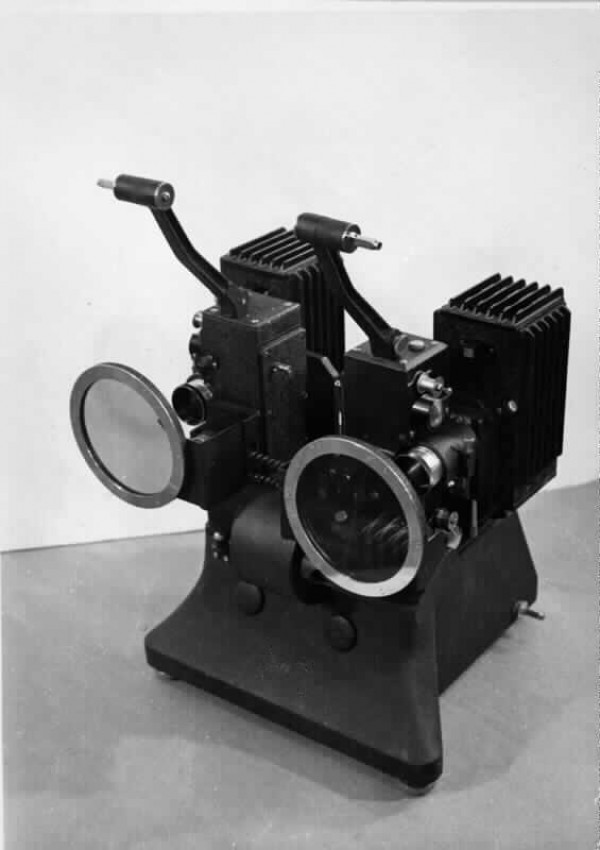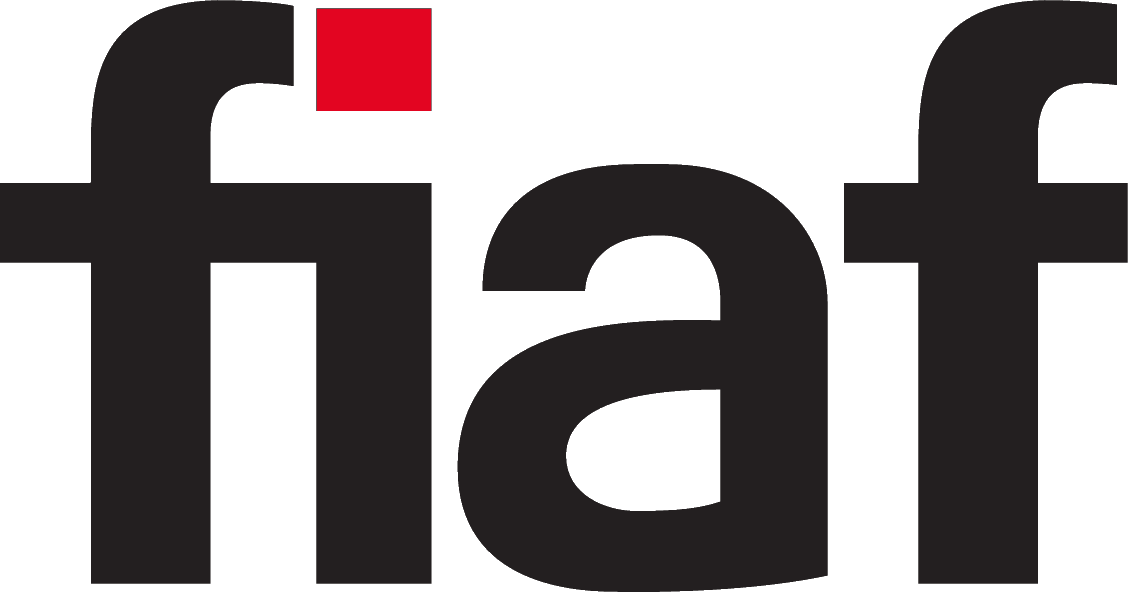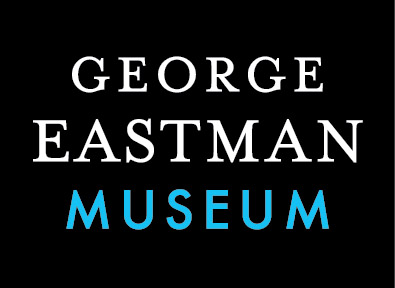Veri-Vision(1938–1953)
A system for producing and screening stereoscopic pictures on 16mm or 35mm, developed in the Netherlands by Frans Reijnders and Frank Anton Weber in the late 1940s.
Film Explorer
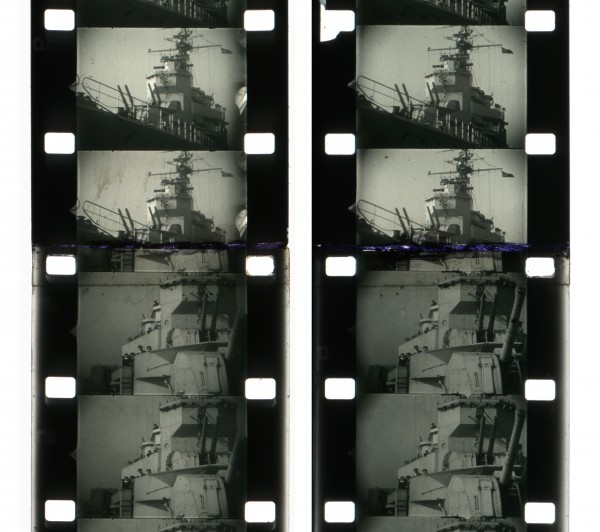
[Untitled demonstration reel] (1948). The Veri-Vision 3-D format used a rig with two 16mm cameras to capture left and right-eye images on two strips of 16mm reversal film. These same strips were projected using a custom 16mm projector set through polarized filters to recreate a three-dimensional image for viewers.
EYE Filmmuseum, Amsterdam, Netherlands.
Identification
1.33:1 (16mm) or 1.37:1 (35mm)
Kodachrome (color demonstration films), and Gevaert (B/W demonstration films).
Unknown
2
B/W or Kodachrome for 16mm demonstration films, and Technicolor for the 35mm film Star of the Screen.
Silent (16mm demonstration films); optical sound (Star of the Screen).
Standard 16mm for the demonstration films; and Academy 35mm for the film Star of the Screen.
B/W, or color.
Unknown
History
Veri-Vision was a system for recording and presenting stereoscopic films. It was developed in the 1930s, and early 1940s, by Dutch doctor Frans Reijnders – following World War II, it was further elaborated by Reijnders, in collaboration with technician Frank Anton Weber.
During the 1920s, Reijnders was stationed as a military doctor at Soesterberg airbase, near Utrecht. While working there, he noticed big differences in the way that individual pilots landed their aircraft. He investigated this phenomenon, and concluded that there was wide variance between individuals, in their ability to perceive depth. He devoted himself to researching depth perception – he subsequently qualified for a private pilot’s license, so that he could self-test his ideas, in practice.
After his time at the airbase, Reijnders settled as a village doctor in Schipluiden, a small community near the city of Delft. His particular interest in depth perception continued, and, as an amateur photographer and filmmaker, he turned his attentions to stereoscopic photography. At this time, he made his first stereoscopic amateur film recordings, and began to develop his theoretical principles.
During the 1930s and 1940s, Reijnders patented several of his stereoscopic inventions – in a number of Western European countries, in the United States, and in Canada.
After the end of World War II, Reijnders came into contact with engineer Frank Weber. They started working together, to perfect the system. They founded the company Veri-Vision to further develop and commercially exploit Reijnders’ ideas.
In the summer of 1948, they completed a some stereoscopic demonstration films, on 16mm – including a film of the newly crowned Queen Juliana of the Netherlands, capturing her first official appearances; and a film of the Dutch female athletics 100m relay team setting a new World Record during a preparatory meet, before the 1948 Summer Olympics, in London – they went on to win the Olympic Gold.
On September 24, 1948, the first presentation of the stereoscopic Veri-Vision system took place, in a private apartment in The Hague. A small gathering witnessed the screening of a number of 3-D demonstration films. The screening proved successful, and about 50 more demonstration screenings followed during the next six months. Most of the guests were scientists, ministry officials and military authorities – but, journalists, representatives of film companies and potential financiers were also invited. In December 1948, Reijnders and Weber even organized a special public screening, at a cinema in The Hague.
Reijnders foresaw a future scientific role for his stereoscopic invention – recording educational films of medical operations and procedures, and other uses in scientific experiments. In contrast, Weber wished to use the system to simulate military exercises, and for commissioned industrial films. He also dreamed of commercial success with professional theatrical exhibition, but, initially, Veri-Vision's future seemed to be focused on science and instruction.
Shortly after the demonstrations, Reijnders and Weber got into a conflict and parted ways. This more, or less, marked the end of Veri Vision. Reijnders did still make a stereoscopic film about an eye operation, as part of his PhD research – and, together with Joop Geesink, he produced the short, color stereoscopic promotional film Star of the Screen (1953) for the Philips Company. It’s the only Veri-Vision film shot on 35mm – all the other films and experiments were shot on 16mm.
Weber kept working on improving the technology – especially the projection of 3-D films. He invented a technique that no longer required viewers to wear color-filtered, or polarised glasses. Spectators sat in fixed seats in an amphitheater-like arrangement. Using a system of rotating slats around the film screen, the image was shuttered alternately to one eye, then the other. This was a mechanically cumbersome system that was never utilized – the concept soon fell into oblivion.
For almost fifty years, Reijnders and Weber’s experiments were forgotten – until 1998, when the Netherlands Film Museum (now Eye Filmmuseum), Amsterdam, restored the films and screened them during a programme of stereoscopic films. The films were screened using the original projector, from the Reijnders and Weber collection at the Netherlands Film Museum.
Since then, the films have been digitised by Eye Filmmuseum and, with the help of amateur 3-D cinematographer Gerard de Boer, processed in such a way that they can now be watched digitally.
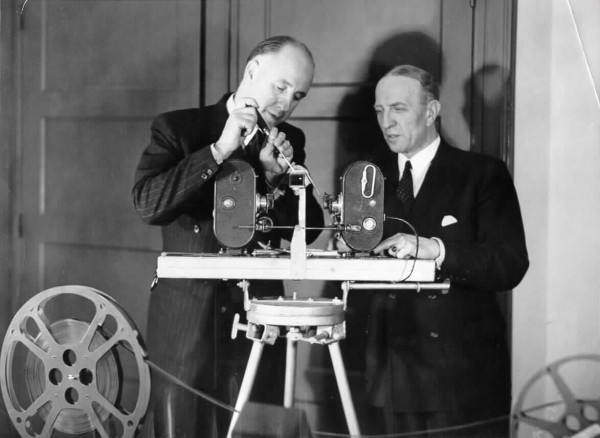
Frank Weber (left) and Frans Reijnders (right), with their 16mm Veri-Vision camera rig.
Eye Filmmuseum, Amsterdam, Netherlands.
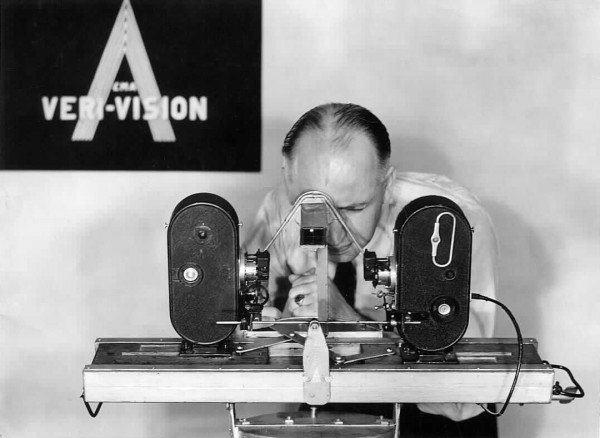
Frank Weber with 16mm camera rig.
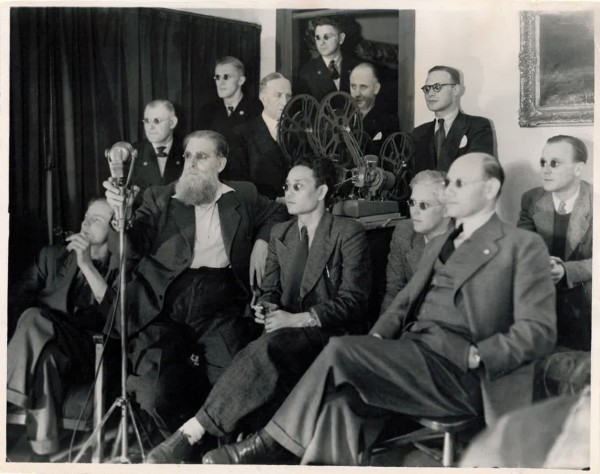
Reijnders and Weber – both without glasses and behind the projector – during a demonstration screening, in The Hague, November/December, 1948.
Selected Filmography
Short promotional film; Technicolor; 35mm.
Short promotional film; Technicolor; 35mm.
20-minute reel; B/W; 16mm. Subjects included: Admiral Helfrich’s Farewell in Rotterdam; Marching Exercises and Drills of Military Motorcyclists; KLM at Schiphol; Final Training of the Dutch Olympic Team at ‘Huis Te Werve’ in Rijswijk, and Ladies Relay, Record Improvement by Fanny Blankers – Koen c.s.; Sailing on the Kaag; Beach Life at Scheveningen; Student Lustrum of Delft Students in 1848 Costumes; First International Motor Races at Zandvoort.
20-minute reel; B/W; 16mm. Subjects included: Admiral Helfrich’s Farewell in Rotterdam; Marching Exercises and Drills of Military Motorcyclists; KLM at Schiphol; Final Training of the Dutch Olympic Team at ‘Huis Te Werve’ in Rijswijk, and Ladies Relay, Record Improvement by Fanny Blankers – Koen c.s.; Sailing on the Kaag; Beach Life at Scheveningen; Student Lustrum of Delft Students in 1848 Costumes; First International Motor Races at Zandvoort.
15-minute reel; Kodachrome; 16mm. Subjects included: Flower Exhibition 1948 at Apeldoorn; Sailing on the Kaag; Student Lustrum of Delft Students in 1848 Costumes; On the Occasion of the Accession to the Throne of H.M. Queen Juliana (Mounted Officers Prepare for the Honorary Escort in The Hague, Harnessing the Golden Coach and Lining up the Grenadiers, Part of the Entry Procession to The Hague, Handing over of Uniforms to the Queen).
15-minute reel; Kodachrome; 16mm. Subjects included: Flower Exhibition 1948 at Apeldoorn; Sailing on the Kaag; Student Lustrum of Delft Students in 1848 Costumes; On the Occasion of the Accession to the Throne of H.M. Queen Juliana (Mounted Officers Prepare for the Honorary Escort in The Hague, Harnessing the Golden Coach and Lining up the Grenadiers, Part of the Entry Procession to The Hague, Handing over of Uniforms to the Queen).
Technology
Frans Reijnders started with the assumption that the thinking behind stereoscopic film recordings attempted in the 1930s, was wrong. It had been assumed that stereoscopic pictures could be made using two synchronized cameras, where the spacing between the two lens axes was equal to the distance between the pupils of our eyes (5.8cm to 6.5cm [2.28 in x 2.56 in]), and that the two optical axes should be parallel. Reijnders proposed that these axes should not be in parallel, but intersect, at an angle of 0.6 degrees, on the object plane. The lenses’ optical axes, and the distance between the two camera lenses, form an isosceles triangle – where the apex angle is 0.6 degrees, and the perpendicular is the distance to the object.
By varying the angle at which the two optical axes intersect, one can get amplification (hyperstereoscopy: 0.6–1.2 degrees), or attenuation (hypostereoscopy: 0.3–0.6 degrees), of the stereoscopic effect. This can be useful when using stereoscopy for medical, instructional, or educational films.
However, a problem starts to arise as the shooting distance is reduced beyond a certain point. To maintain the stereoscopic effect, the angle of optical convergence must remain close to 0.6 degrees – as object distance reduces, there comes a point where the required distance between the lens axes is shorter than is physically achievable, given the dimensions of the camera equipment. It becomes impossible to take 3-D shots at any closer distance.
Reijnders resolved to overcome this problem by using mirrors to redirect one of the two optical axes.
In the 1940s, Weber and Reijnders designed an improved version of the 3-D rig, in which the cameras were placed with their lenses facing each other (and perpendicular to the direction of shooting). In front of each camera lens, he placed a small prism – these allowed him to vary the angle at which the optical axes of the two cameras converged. With this arrangement, it became possible to shoot 3-D footage of objects as close as 1m (3.28 ft). Adjustments to exposure had to be made to compensate for the light lost passing through the reflecting prisms.
The two cameras were driven by a common drive shaft – synchronizing the start of each shot and shooting speed (fps). Weber and Reijnders used this camera rig to shoot their initial demonstration films.
Weber also improved the dual-projection setup: there were two projectors – one for the right-eye film, and one for the left-eye film. The optical axes of the projectors also intersected at an angle of 0.6 degrees on the projection screen.
Both projectors were also shaft-driven – synchronizing both the start frame, and projection speed. In front of the projection lenses, he put polarization filters, which polarized the light at 90 degrees to each other. The projection screen was a “silver screen” that did not scatter the light, but reflected it perpendicularly. Viewers wore special glasses with polarized lenses, which matched the polarization angle of the left- and right-eye projected images.
All demonstration films were shot on 16mm – both in B/W, and in color. For the demonstration films, Weber and Reijnders employed two Stewart-Warner Hollywood 531 B Deluxe 16mm cameras.
Ver-Vision camera setup for 3-D film (1947). Film made by Gerard de Boer in 2012.
References
Patents
Reijnders, Franciscus Henricus. Inrichting voor het stereoscopisch waarnemen van op een verticaal vlak geprojecteerde beelden. Dutch Patent 50187, March 18, 1941.
Reijnders, Franciscus Henricus. Werkwijze en camera voor het opnemen van stereoscopische beelden onder vermijding van abnormaal-stereoscopisch effect. Dutch Patent 56669, July 5, 1941.
Reijnders, Franciscus Henricus. An Apparatus for the Stereoscopic Observations of Images Projected on a Vertical Plane. British Patent 619,000, November 19, 1946.
Reijnders, Franciscus Henricus. Improvements in or relating to Apparatus for Taking Stereoscopic Pictures without Abnormal Stereoscopic Effects. British Patent 670,615, December 18, 1946.
Reijnders, Franciscus Henricus. Camera voor het opnemen van beelden met stereoscopische werking, waarbij de optische assen elkaar snijden in het object en welke camera is voorzien van een instelorgaan, dat de basislengte rechtevenredig met de objectafstand wijzigt. Dutch Patent 69363, June 1, 1949.
Reijnders, Franciscus Henricus. Apparatus for taking stereoscopic pictures without abnormal stereoscopic effects. US patent 2,595,409, filed February 10, 1947, and issued May 6, 1952.
Compare
Related entries
Author
Rommy Albers is Senior curator at the Eye Filmmuseum in Amsterdam. His fields of expertise are Dutch film history, and experimental film. He is editor of the book Film in Nederland [Film in the Netherlands] (2004), and numerous articles on Dutch film history and experimental film.
Thanks to Gerard de Boer – for both technical support, and the production of the embedded video.
Albers, Rommy (2025). “Veri-Vision”. In James Layton (ed.), Film Atlas. www.filmatlas.com. Brussels: International Federation of Film Archives / Rochester, NY: George Eastman Museum.

